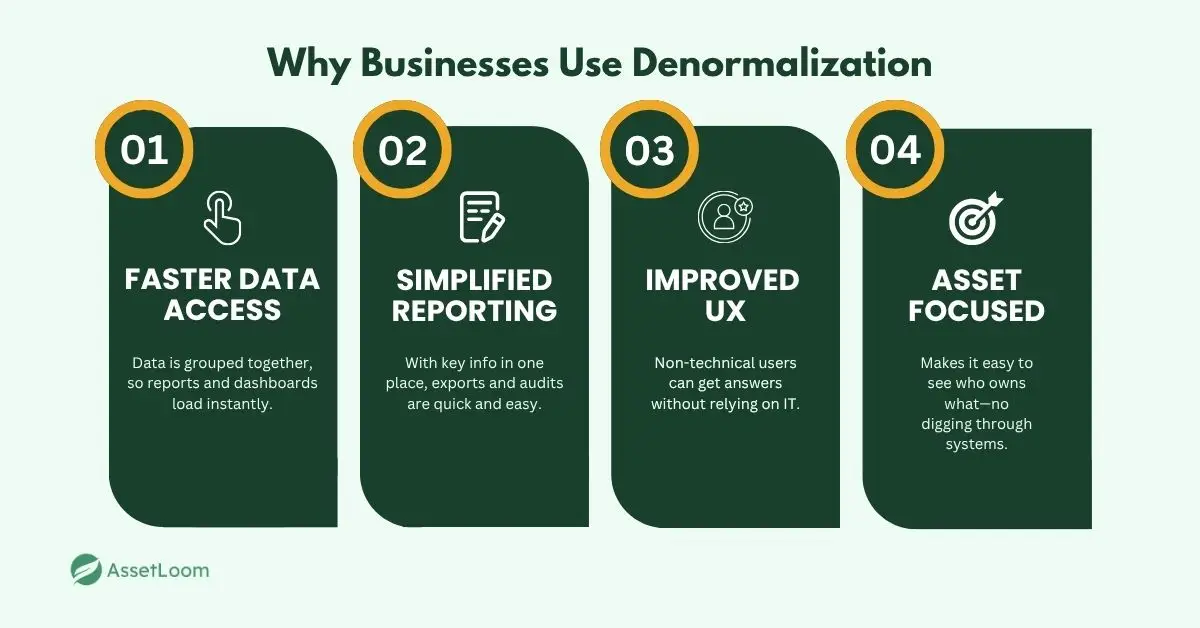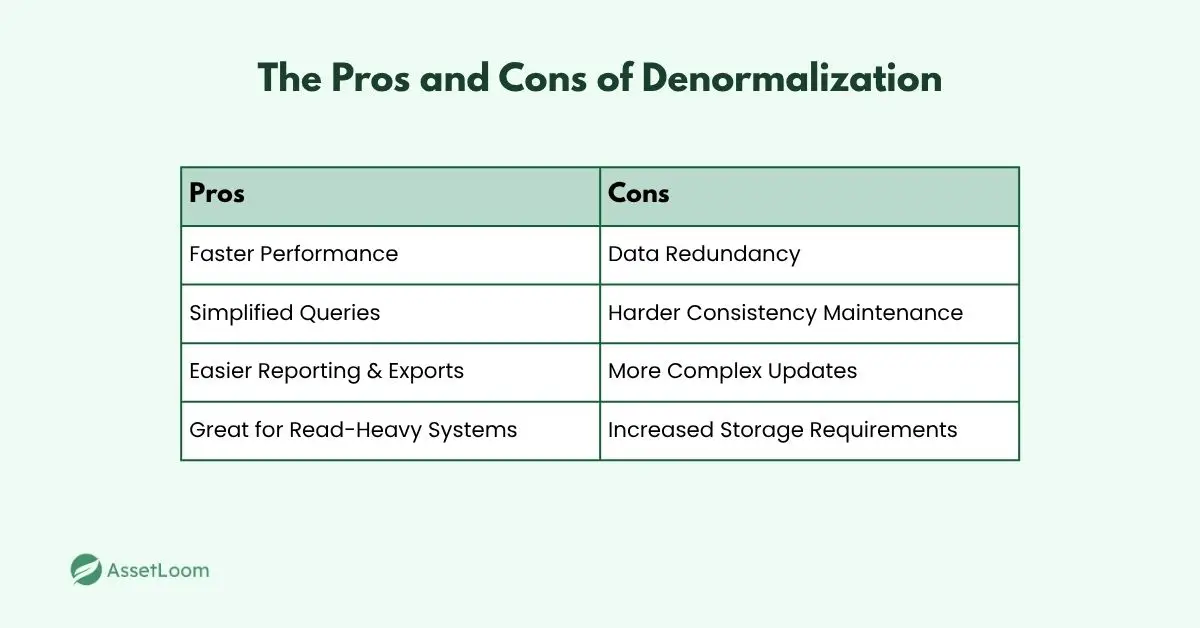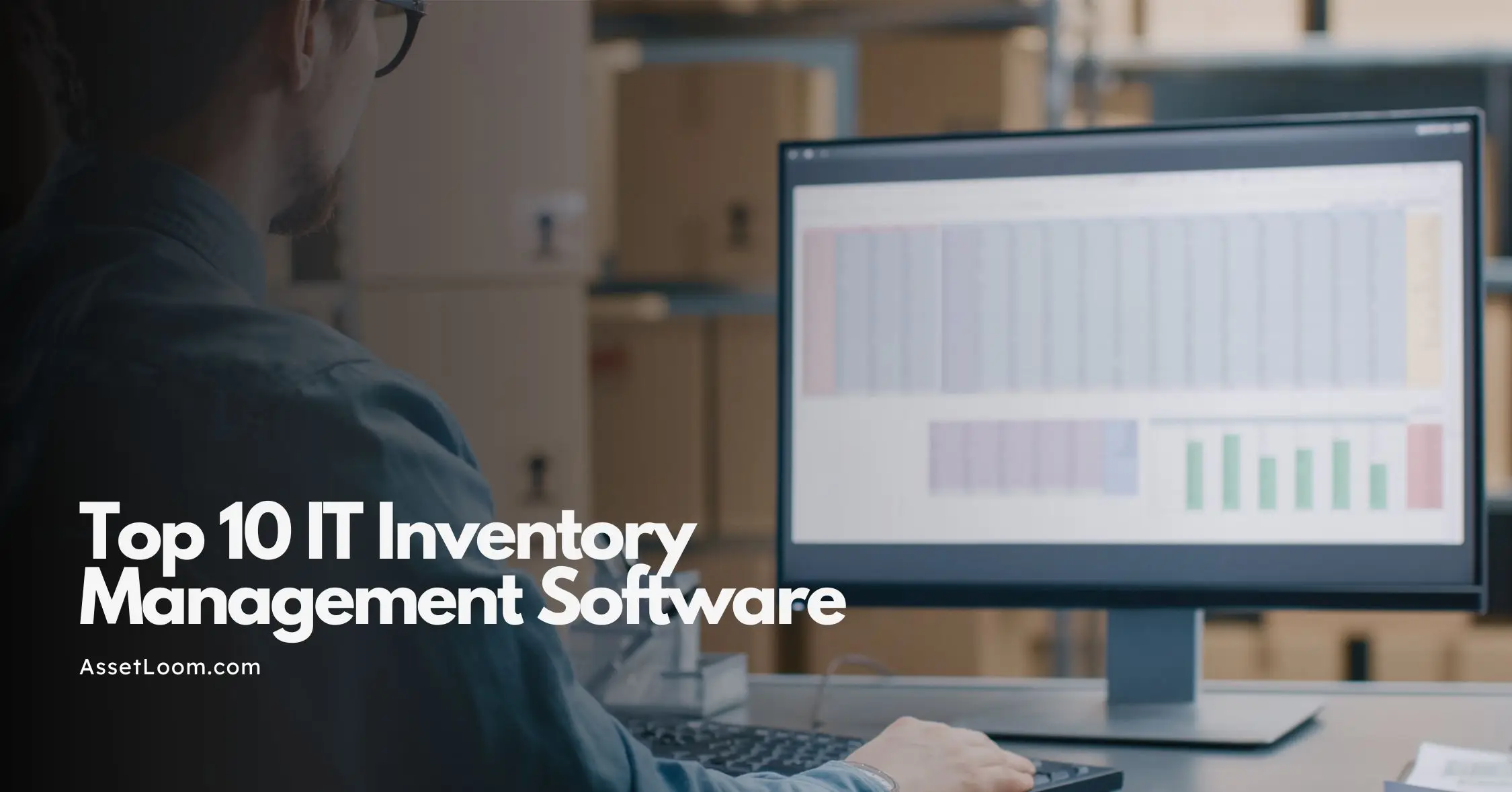What is Denormalization in Databases? A Simple Guide for Non-Techies
Learn what denormalization in databases means, why businesses use it, and how it boosts speed, explained in plain English for non-technical readers.
Ever tried finding out who’s using what laptop at work, only to get stuck waiting for a report to load… or worse, having to ask IT to dig through five different systems?
That frustrating delay? It often comes from how the data is stored. In most systems, details are split up across different tables—like having names in one list, devices in another, and departments in a third. It’s tidy, but slow.
Denormalization changes that.
It’s a fancy word for a simple idea: put the most useful info in one place, even if it means repeating some of it. So instead of connecting three different tables just to see who has a laptop, the system already knows—and shows you instantly.
It’s not just a database trick. It’s a time-saver, a stress-reducer, and a big win for anyone who just wants things to work... fast.
In this guide, we’ll break down exactly what denormalization is, why it helps, and how businesses use it to run smarter, not harder.
Let’s dive in—no tech degree required.
So, What Exactly Is Denormalization in Databases?
Let’s strip away the jargon.
Denormalization is when we combine pieces of data—even if it means repeating some information—to make it easier and faster to find what we need.
In a typical database, things are kept neat and tidy. For example:
- Employee names are in one table
- Devices are in another
- Departments are in a third
This setup is great for keeping everything organized (called normalization), but it means the system has to constantly join different tables together to answer even a simple question, like “Who has this laptop?”
Denormalization skips the join.
It says, “Hey, let’s just copy the employee’s name and department into the device record.” That way, when you look up the laptop, all the details are right there—no digging.
Is it a little repetitive? Yes. Does it save a ton of time? Absolutely.
Think of it like saving a screenshot of all the info you need in one place, rather than flipping back and forth between tabs every time.
Why Do Businesses Use Denormalization?
Let’s say you manage hundreds—or even thousands—of devices across departments. Every time someone asks, “Who has what laptop?” or “Which assets are assigned to Marketing?”, your system needs to pull details from multiple places just to give you an answer.
This is where denormalization delivers real performance benefits.
By storing key information together—like the employee’s name, department, and assigned device—all in one place, systems can respond faster and more efficiently. There’s no need to piece things together from multiple tables every time a question is asked.
Here’s why this matters in a business setting:
- Faster access to data: Reports run quicker, dashboards load faster, and users don’t wait around for results.
- Simpler reporting and exports: With everything already in one place, generating reports or audits becomes much more straightforward—no technical know-how required.
- Better user experience: Non-technical staff can get the information they need without relying on IT or understanding complex database queries.
- Especially useful in IT environments: In areas like IT Inventory Management, denormalization allows teams to quickly see who owns what, where it’s located, and whether it’s still in use—all without complicated lookups.
In short, denormalization helps businesses streamline their operations by making data more accessible, reducing system lag, and supporting faster decision-making.

Real-World Examples of Denormalization
The best way to understand denormalization is to see how it plays out in everyday business scenarios. Here are a few practical examples that show why companies choose to duplicate data on purpose.
1. E-commerce Order Management
In an online store, customer details are usually stored in a separate “Customers” table. Each order refers back to that table to get the customer’s name, email, and address.
With denormalization, the store saves the customer’s name and shipping info directly in the “Orders” table. That way, orders can be processed and displayed quickly, especially helpful when viewing order history or printing shipping labels.
2. Banking Transactions
A bank typically stores customer profiles separately from transaction records. But for reporting and statement generation, it helps to include basic customer info—like name and account type—within each transaction record.
This makes pulling a full transaction history faster and easier, especially when the data needs to be shared externally or exported regularly.
3. IT Asset Management
In platforms like AssetLoom, assets (like laptops, monitors, phones) are often assigned to employees. In a normalized setup, employee names and departments would live in a separate table.
But with denormalization, key employee details—such as name, department, or location—are stored directly with the asset. This means you can instantly run reports like “all laptops assigned to Sales in New York” without multiple lookups.
4. Business Intelligence & Reporting Systems
Many Business Intelligence tools work with huge volumes of data. To avoid slowing down dashboards with constant joins, companies often denormalize by building summary tables that include all the key metrics in one place.
This helps with quick filtering, slicing, and visualizing data, without dragging down performance.
Each of these examples shows how denormalization is used not because it's cleaner, but because it’s faster, more practical, and better suited for real-world business needs.
The Pros and Cons of Denormalization
Like most shortcuts, denormalization comes with trade-offs. It’s not always the right choice, but when used wisely, it can significantly improve performance and user experience. Here’s a look at the benefits and drawbacks.
Pros of Denormalization
- Faster performance: Because the data is already grouped together, systems don’t have to do time-consuming joins. That means quicker reports, faster dashboards, and smoother user interactions.
- Simplified queries: Developers and analysts don’t have to stitch together data from multiple tables to get the information they need.
- Better for reporting and exports: When all the necessary data is stored together, generating reports and exporting data becomes a lot easier, especially for non-technical users.
- Ideal for read-heavy systems: Denormalization is particularly useful in systems where data is read often but updated less frequently, like analytics tools, dashboards, and asset tracking platforms.
Cons of Denormalization
- Data redundancy: The same information (like an employee's name or department) may be stored in many different places. That takes up more space and can be harder to manage.
- Harder to maintain consistency: If a piece of data changes (like an employee’s department), it must be updated everywhere it appears. Otherwise, you risk having outdated or mismatched information.
- More complex updates: Maintaining redundant data synchronization across records can necessitate additional logic, processes, or automation, particularly in larger systems.
Denormalization isn’t about doing things “wrong”—it’s about choosing what’s right for your system’s needs. If speed, simplicity, and reporting are priorities, the benefits can far outweigh the downsides.

Final Takeaway: Less Perfect, More Practical
In a perfect world, every piece of data would live in one neat place. But in the real world—where speed matters, teams move fast, and no one has time to wait on a spinning report—practical beats perfect.
That’s the heart of denormalization.
It’s not about breaking the rules. It’s about bending them just enough to make systems more useful for real people doing real work. It’s the reason your IT team can pull up a report in seconds, or why your asset management dashboard doesn’t leave you hanging.
Denormalization isn’t a flaw in the system—it’s a feature. A deliberate, smart shortcut that keeps your business running smoother behind the scenes.
You might not notice it. But when things just work—that’s probably denormalization doing its job.

Related Blogs
Subscribe for Expert Tips and Updates
Receive the latest news from AssetLoom, right in your inbox.

